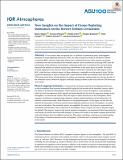| dc.contributor.author | Abalos, Marta | |
| dc.contributor.author | Polvani, Lorenzo | |
| dc.contributor.author | Calvo, Natalia | |
| dc.contributor.author | Kinnison, Douglas | |
| dc.contributor.author | Ploeger, Felix | |
| dc.contributor.author | Randel, William | |
| dc.contributor.author | Solomon, Susan | |
| dc.date.accessioned | 2021-10-27T20:10:39Z | |
| dc.date.available | 2021-10-27T20:10:39Z | |
| dc.date.issued | 2019 | |
| dc.identifier.uri | https://hdl.handle.net/1721.1/135086 | |
| dc.description.abstract | ©2019. American Geophysical Union. All Rights Reserved. It has recently been recognized that, in addition to greenhouse gases, anthropogenic emissions of ozone-depleting substances (ODS) can induce long-term trends in the Brewer-Dobson circulation (BDC). Several studies have shown that a substantial fraction of the residual circulation acceleration over the last decades of the twentieth century can be attributed to increasing ODS. Here the mechanisms of this influence are examined, comparing model runs to reanalysis data and evaluating separately the residual circulation and mixing contributions to the mean age of air trends. The effects of ozone depletion in the Antarctic lower stratosphere are found to dominate the ODS impact on the BDC, while the direct radiative impact of these substances is negligible over the period of study. We find qualitative agreement in austral summer BDC trends between model and reanalysis data and show that ODS are the main driver of both residual circulation and isentropic mixing trends over the last decades of the twentieth century. Moreover, aging by isentropic mixing is shown to play a key role on ODS-driven age of air trends. | |
| dc.language.iso | en | |
| dc.publisher | American Geophysical Union (AGU) | |
| dc.relation.isversionof | 10.1029/2018JD029301 | |
| dc.rights | Article is made available in accordance with the publisher's policy and may be subject to US copyright law. Please refer to the publisher's site for terms of use. | |
| dc.source | American Geophysical Union (AGU) | |
| dc.title | New Insights on the Impact of Ozone‐Depleting Substances on the Brewer‐Dobson Circulation | |
| dc.type | Article | |
| dc.contributor.department | Massachusetts Institute of Technology. Department of Earth, Atmospheric, and Planetary Sciences | |
| dc.relation.journal | Journal of Geophysical Research: Atmospheres | |
| dc.eprint.version | Final published version | |
| dc.type.uri | http://purl.org/eprint/type/JournalArticle | |
| eprint.status | http://purl.org/eprint/status/PeerReviewed | |
| dc.date.updated | 2020-05-06T16:30:30Z | |
| dspace.orderedauthors | Abalos, M; Polvani, L; Calvo, N; Kinnison, D; Ploeger, F; Randel, W; Solomon, S | |
| dspace.date.submission | 2020-05-06T16:30:35Z | |
| mit.journal.volume | 124 | |
| mit.journal.issue | 5 | |
| mit.license | PUBLISHER_POLICY | |
| mit.metadata.status | Authority Work and Publication Information Needed | |
